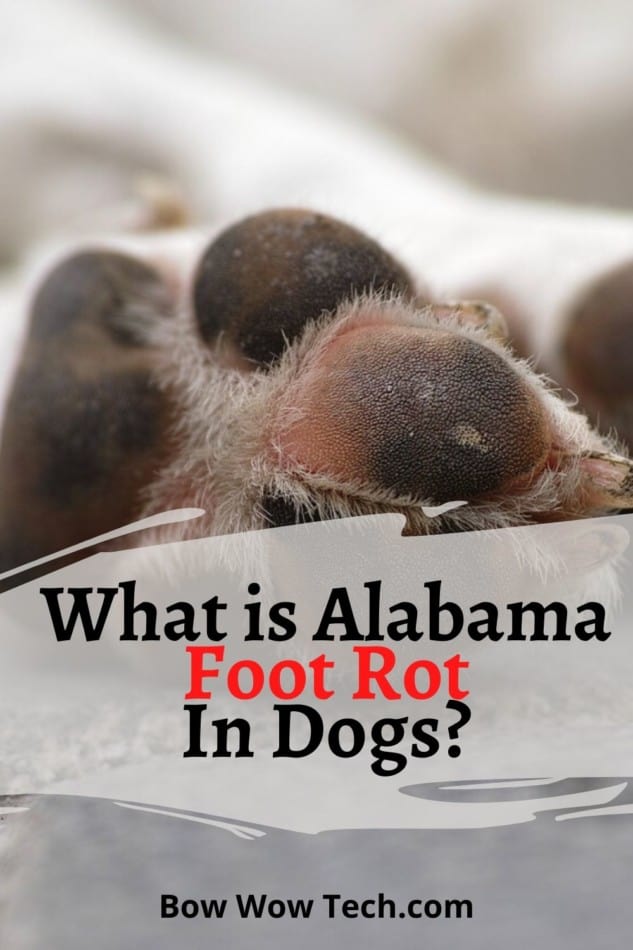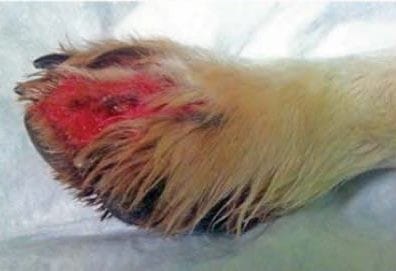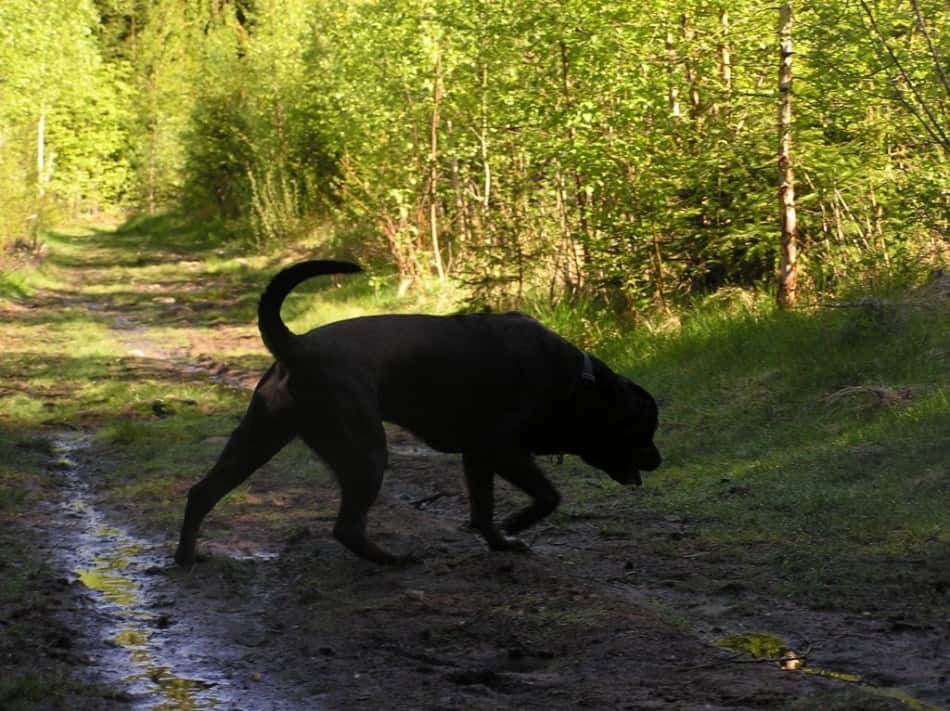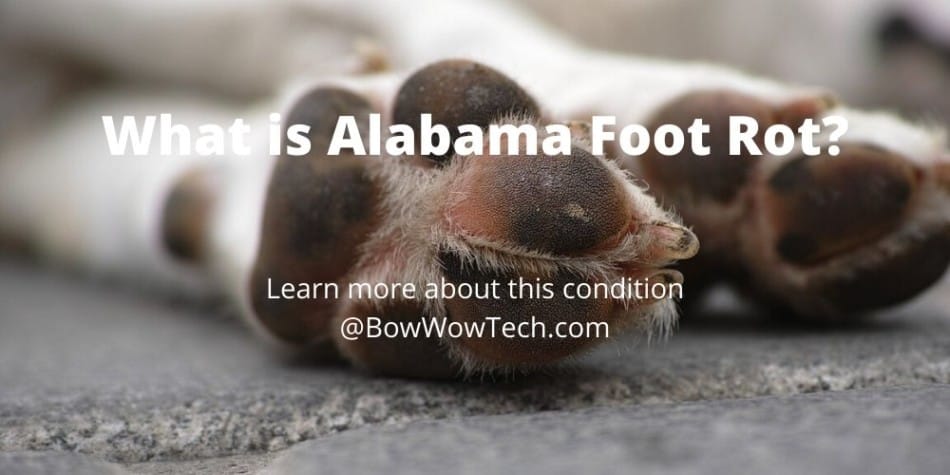Alabama foot rot, what the heck is that? Well, I myself had never heard of it until recently. Whilst sitting watching the TV, my sister noticed that the pup (not yet 2 years old) was continuously licking one of his paws.
She gently inspected the area to see if he’d maybe got a thorn or something similar stuck in there. He seemed ok in himself other than this continuous licking.
The following day, the pup was limping: Shortly after, he was hopping. Further examination of the affected paw showed some swelling but nothing much else.
What is Alabama Foot Rot? Medical experts say that Alabama Foot Rot is a disease affecting dogs by causing damage to the skin and kidney’s blood vessels.

Time for a visit to the vet; she pronounced it was likely a dislocated toe. Pain injection given, paw bandaged and booted up, pills prescribed, and a follow-up visit booked.
The day after, pup is now crying and finding it difficult to walk at all; he can’t even take his own weight to jump up onto his favourite place on the settee, next to his mum.
A phone call to the vet ended in an emergency appointment the same day. Blood was taken and an X-ray done; no, it’s not a dislocated toe, nor is it broken bones – Alabama Foot Rot – huh?
Yes, Alabama Foot Rot. I’d never heard of it and neither had my family, who’ve had dogs for over 40 years.

Table of Contents
So just what is Alabama Foot Rot?
Cutaneous and Renal Glomerular Vasculopathy (CRGV) is the scientific name for Alabama Rot and is a disease that can be fatal. It damages the skin’s blood vessels as well as the blood vessels and lining of the kidneys. Blood clots in these vessels cause swelling and lesions and will damage the kidneys – fatally.
Not only is it difficult to identify, but it is also hard to treat.
First discovered in the USA in the 1980’s, it was thought to be linked to the E-coli bacteria. It was not identified in the UK until 2012 but cases have continued to grow.
Is Alabama Foot Rot Seasonal?
Interestingly, dogs that have been affected by this dreadful ailment in the UK, seem to contract it between November and May. This appears to suggest that it’s the cold and wet times of the year that vets see more cases.
Walking in muddy areas, including woodlands and fields could well be the areas where this disease is picked up. Latest figures show that there have been 4 cases so far in 2020.

Which Dogs are Affected by CRVG?
It can affect any dog, of any breed, of any sex, of any age and of any size. Frightening indeed.
What’s more frightening is that it can be fatal if not caught quickly and treated urgently.
What Causes Alabama Foot Rot?
The actual cause of Alabama Foot Rot is still not known. It is muted in the USA that it’s related to E. Coli bacteria held in muddy ground; which, when your furry friend bounds around, picks up the bacteria in one of particular parts of its body – usually the paws/legs, the belly or the face/snout.
However, cases in the UK show no evidence of E. Coli being the cause of affected dogs.
Symptoms of Alabama Foot Rot
The general symptoms of CRVG are shown below:
- Skin sores
- Lesions
- Swelling around the affected area
- Possibly open ulcers
- Your pup may lose its appetite
- Continuously licking the area where the infection has taken hold
What You Can Do to Prevent CRVG in Your Dog
Because the cause of Alabama Foot Rot is unknown, there is no known way of actually preventing your dog becoming affected and no vaccine is currently available.
However, there are several things you can do to help protect your canine contracting Alabama Foot Rot. Firstly, avoid muddy areas for your daily walks together. If you must allow frolicking in muddy fields or woodlands, it’s wise to fit boots to your dog’s paws.
After every walk (particularly in muddy areas/fields and woodlands), check for signs of infection.
Some dogs really do not take to wearing boots and may well cause such a fuss, that to continue to persist would be unkind. Applying a special wax for dogs may be an alternative to boots.
In all cases of muddy dog walkies, you must ensure that you thoroughly wash, rinse and dry the paws. Use an antibacterial doggie wash for better protection.
Summary: Alabama Foot Rot | CRVG
Whilst this disease is generally fatal with few survivors, no known cause and no vaccine, it is extremely rare.
Continue your daily routine of checking your furry friend after every walk for any signs of any infections, swellings or skin damage. Always refer worries to your vet.
For further information:
- For updates (2019) on CRVG: Update on Alabama Rot
- Vets 4 Pets show you a step-by-step guide along with a map of affected areas in the UK
- Spotting the signs of Alabama Rot, you may find this link useful:
- Signs of kidney failure in dogs
All products in this article can be found on amazon, any links which are clicked and subsequently purchased may provide us (bowwowtech.co.uk) with a small commission. Any commissions earned are reinvested to enable us to produce more articles and provide educational material to visitors to our site.
Disclaimer:
Bowwowtech.co.uk does not provide veterinary advice. Our aim is to provide the reader with information to enable them to make a good decision when making a purchase. All content is therefore for informational purposes only.

